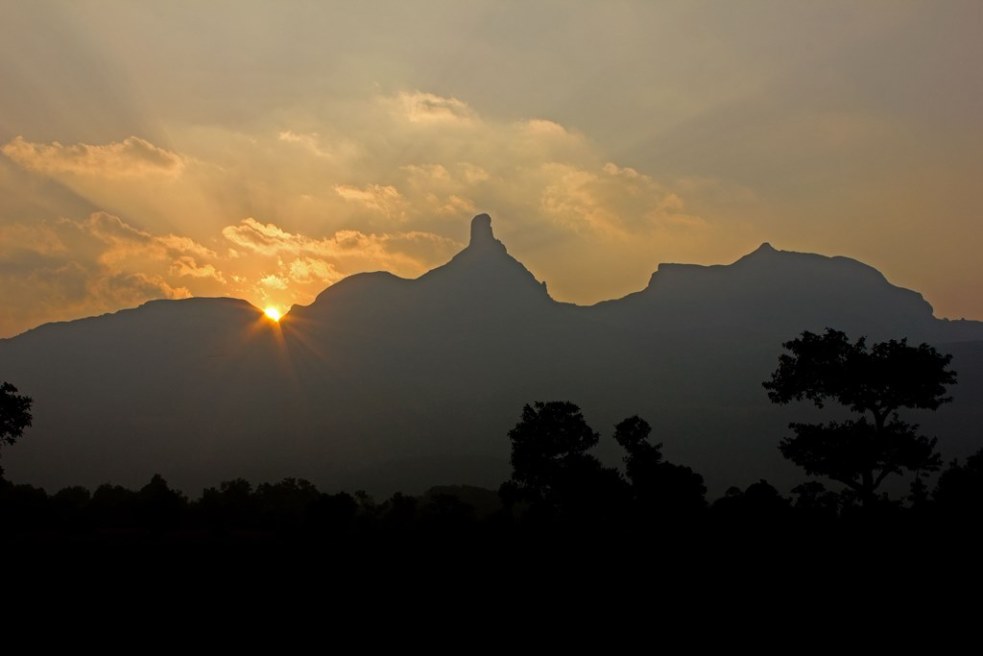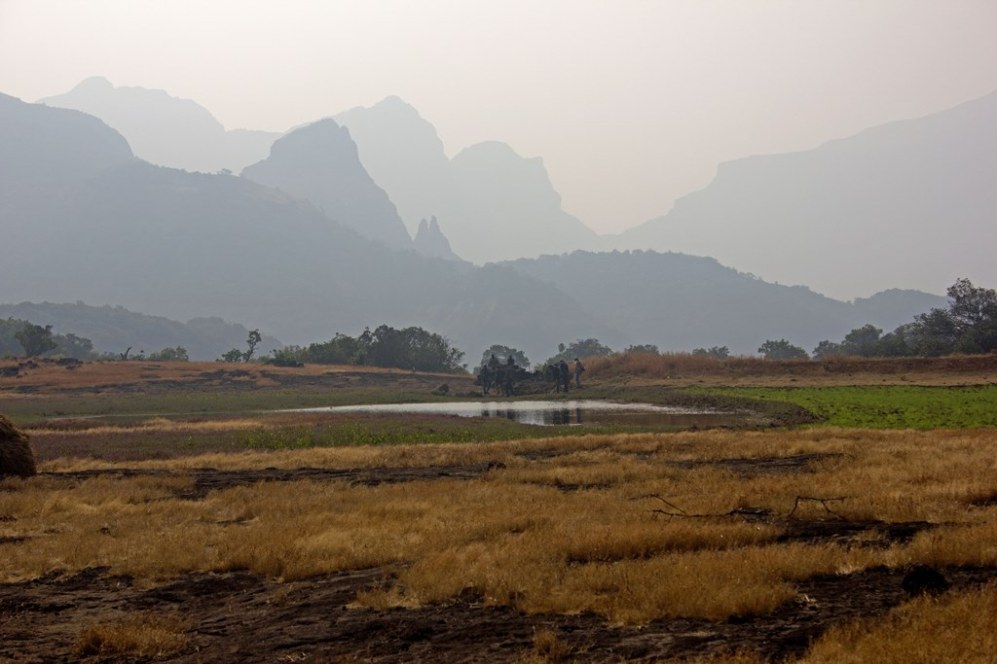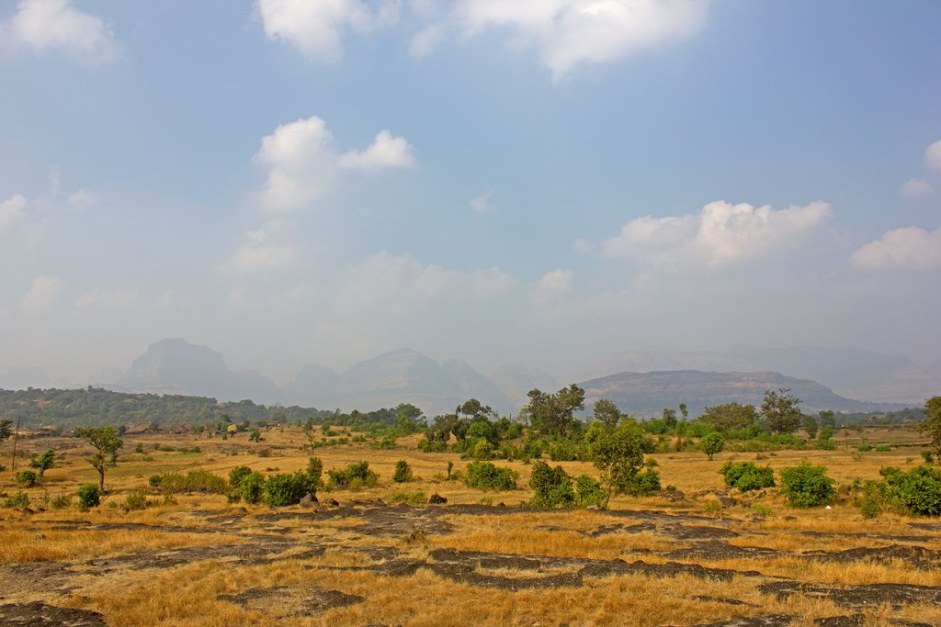….. Rajesh Deshpande. (Based upon my personal visit in December 2013)
Sandhan (सांधण) Valley is a destination off the beaten track known only to trekkers and mountaineers. Sandhan Valley could have been included in the ‘Things to see’ section of the Bhandardara page of this blog, however due to the sheer beauty and excitement packed in this place it is imperative to dedicate a page for this destination.
Sandhan Valley is a gorge cut by wild water streams gushing down ferociously from nearby mountains during the monsoons for past thousands of years. The streams fall in to the valley beyond the gorge and form a pond. To reach the pond one has to rappel down from the far end of the gorge in to the valley. The views from the far end of the gorge are truly breath taking and the experience is amazing.

Sandhan Valley is located in the Ahmednagar District of Maharashtra in the Akole taluka. It can be reached from Samrad village which is the base village. Samrad is approx. 30 Kms from Bhandardara and 3 Kms off the Ghatghar Dam road. Sandhan Valley is known by many names viz. Valley of Suspense, Valley of Shadows, and Grand Canyon of Maharashtra. However, Sandhan is no comparison to the Grand Canyon in the Arizona State of USA which is a 445 Kms long canyon cut by the Colorado River, Sandhan is barely 2 Kms long. Sunrays reach the gorge only for a short span of time during the day when the sun is directly above the gorge, thus the gorge remains in shadow for most part of the day. There is no suspense in the gorge or the valley beneath. Sandhan Valley is a wonder of nature with stunning views, chilly weather and the spellbound majesty of nature.
Best time to visit Sandhan Valley is during winters from November till February. Sandhan valley is inaccessible in the monsoons as the area witnesses heavy rainfall.

How to Reach?
By Rail – The nearest railhead is Igatpuri. Any long distance train bound towards Nasik from Mumbai halts at Igatpuri. From Igatpuri local taxi’s, jeeps and public transport is available to Samrad which is about 60 Kms
By Road – From Mumbai, take National Highway 3 (NH-3) to Nasik till Ghoti toll plaza. About 2 Kms after the toll plaza, take a right turn for Shirdi (this is the new alternate road to Shirdi via Sangamner called as the Ghoti Shirdi road). About 7 Kms ahead take another right turn which leads to Bhandardara, about 6 Kms after crossing Bari village (Bari is the base village for Mount Kalsubai, highest peak of Maharashtra at 5400 ft. ASL) is a junction on the outskirts of Shendi village. A right turn from here leads to an ascend uphill towards MTDC and Anandvan resorts. The road ahead leads to Ghatghar which is 28 Kms from here. On reaching Ghatghar RCC dam, a left turn leads to Samrad village about 3 Kms inside.
By Air – Chhatrapati Shivaji International Airport, Mumbai is the nearest Airport, 210 Kms away.

Where to stay?
Being a remote village there are no hotels in Samrad. The locals make homestay arrangements. Trekkers and Mountaineers can opt to stay in their own camping tents carried along. There are no shops in Samrad, hence it is recommended to carry snacks, packaged drinking water and medicines. Clean drinking water is also available from nearby well. There are no toilets in Samrad hence one has to make own sanitation arrangements in the open jungle. Stay put in the lap of nature in a camping tent is a thrilling experience and undoubtedly the best stay option. For a more cosy and warm accommodation opt for homestay. Home cooked local Maharashtrian fare is available consisting of Bhakri, Bhaji, Dal, Usal, Rice, Thecha and pickle. Breakfast could be Poha, Upma or Maggi with piping hot tea all cooked on a clay oven. Samrad has electricity supplied through Solar Rural Lighting.
Things to see and do
Sandhan Valley – From Samrad village a 2 Km. walk in the southern direction leads to the entrance of Sandhan gorge. The trail isn’t visible and thus difficult to find without local assistance. On reaching the entrance of the gorge, a steep descend through craggy boulders leads to the first water pond in the gorge. The water level in the pond depletes every month till monsoon. Typically it is knee deep in the month of December. After crossing the first pond a descend through rock boulders leads to the second pond which is even deeper and longer. Typically in December the water is up to the chest level. After crossing the second pond, the path is relatively easy through small rocks till the far end of the gorge. Inside the gorge there’s 300 feet high rock wall on both the sides along the serpentine path. Typically an average trekker returns back from the far end point through the same route. This requires an ascend up to 300 feet on the way back climbing the rock boulders. It could be very tiring in summers.

The intrepid trekker can descend the valley beneath the far end of the gorge through rappelling. There are three big rock stretches, one 40 feet high, while the other two relatively smaller at 15 feet and 10 feet. Post descend there’s a beautiful pond formed by the gushing water downhill. There’s ample space for camping around the pond. It takes typically 4 – 5 hours to descend up to the pond. Many trekkers’ camp overnight near the pond. A panoramic view of the peaks around includes the Bann pinnacle and Ajoba hill. Further descend from the pond leads to Dehne village which is the base village for Ajoba hill trek. From Dehne village, state transport buses are available for Asangaon railway station. As an alternative it is also possible to return to Samrad village from the pond, it takes another 4 – 5 hrs. to reach Samrad.
General Tips and Safety Guidelines
Although trekker’s have classified Sandhan Valley as an ‘Easy’ grade trek, it requires a fair amount of endurance and stamina to cross the gorge. The valley descend up to the pond is considered to be of ‘Moderate’ grade as rappelling is required. This part should be attempted under professional guidance. Good quality trekking shoes with good grip on the slippery rocks are extremely essential. Please do not carry sling bags or Jholas, a rucksack is essential if planning to descend the valley and camp near the pond beneath. Carry sufficient drinking water and Electral or Enerzal to replenish lost electrolytes.
It is highly recommended to avail services of a local guide while visiting Sandhan Valley, the trails are misleading and one may get lost in the jungle easily. The locals can be of great help in case of medical emergencies or injuries.
Do not shout in the gorge out of excitement, the energy released out of reverberation caused due to loud sound hitting back and forth on the narrow walls can dislodge loose rocks which can fall and crush people below. Shouting can also scare monkeys wandering on top of the rock walls of the gorge; they may start running out of fear thus dislodging loose rocks. Monkeys may also turn mischievous and pelt stones or snatch bags for food. Do not feed monkeys; they have ample food available in their natural habitat.
Do not walk in the middle of the gorge to avoid casualties due to loose rocks falling down; take cover of the walls while walking. Be careful while crossing the pond as the water is chilled and the rocks beneath are very slippery.
During winters, the weather is very chilly thus making it essential to carry warm woollens; temperature can drop up to 12oC in the night. It is also essential to carry bed sheets, sleeping bags, air beds and air pillows or equivalent bedding for a comfortable sleep. Carry essential medicines. A Torch is extremely essential, carry extra batteries. Also carry Dry snacks, Dry Fruits, Plum Cake, Chocolate bars and Biscuits. Avoid farsans and oily snacks.
Marathi is the most widely spoken local language while the locals also speak in Hindi and understand English. Many locals serve as guides and make homestay arrangements in their homes for travellers at nominal cost. They are friendly, simple and hospitable people.

Konkan Kada – is a naturally formed viewing gallery about 3 Kms from Samrad in the south west direction. A broken trail leads to Kokan Kada of Samrad or Ghatghar. Down the valley is Thane district while the kada (cliff) is in Ahmednagar district. Kokan Kada offers breath taking view of the high mountains around.
Star Gazing – The skies above Sandhan valley are darkest in Maharashtra and offers imposing view of the heavens above thus making it an ideal place for photography and astronomy. The skies are absolutely free of stray city light or vehicle lights lighting up the sky or causing a halo. The skies are ideal for time lapse or long exposure photography and for Astronomy. A good telescope, binoculars and DSLR camera are thus necessary for pursuing interests in astronomy or photography. A new moon night is thus an ideal time to camp under the darkest skies.
Trekking – Sandhan valley and Bhandardara region is surrounded by mighty mountains from all sides offering challenging treks. The trekking grade could be ‘Moderate’ or ‘Difficult’ thus requiring good endurance and experience. Treks in this region are not recommended for novice trekkers. The most challenging trek is a trek popularly known as the AMK named after the three mountains Alang, Madangad and Kulang to the northern side of Samrad. Far north is Mount Kalsubai, the highest peak of Maharashtra at 5400 feet ASL. At close proximity from Samrad in the east direction is the famous Ratangad and to the south stand high the Ajoba and the Bann peaks. All the peaks are amongst the mightiest peaks in the Sahyadri range.

What to eat?
Local Maharashtrian fare of Bhakri, Bhaji, Dal, Rice, Usal and Pickle is the only available meal in the village houses at Samrad. Poha, Upma and Maggi are popular on the breakfast menu along with tea. There are no shops or eateries at Samrad. Own arrangements must be made at one of the village homes. The villagers are friendly, hospitable and helpful people, alongside farming they earn a livelihood by making food and stay arrangements for trekkers and picnickers at a very nominal cost.
Suggested Itinerary and Things to Carry
Sandhan can be planned as a weekend trek. There are two options viz. Exploration with camping OR Exploration with Valley Descend (requires rappelling). Ideally leave on Friday night from Mumbai, Pune or Nasik so as to reach Samrad early morning on Saturday. Rest till dawn, freshen up. Post breakfast start to explore Sandhan Valley along with a local guide. It requires 4 hours to explore the gorge and return at a leisurely pace. Have lunch after returning from Sandhan valley. As the night falls mount telescopes and cameras on tripods for photography and astronomy. Cook dinner on fire wood available around in the jungle. Enjoy leisure activity around a bonfire. Retire in tents or village home. Next day i.e. Sunday – freshen up and post breakfast explore Konkan Kada. Leave Samrad and move towards Amruteshwar and further to Bhandardara. Post Lunch at Bhandardara, return home.
Sandhan if planned as a full descend trek needs a change in above itinerary as follows – leave Samrad on Saturday morning post breakfast with all baggage, camping and rappelling gear. Rappel down and descend to the pond and camp near the pond overnight. On Sunday morning either descend further to Dehne village and take public transport onward to Asangaon for returning back home OR reach Samrad from a route through Karoli ghat and return home.
Things to carry
If going for exploring only the gorge and for camping – Good trekking shoes, Packaged Drinking Water, essential medicines, Torch, Multi-tool kit, Tissue Paper and basic toiletries, warm woollens, bedding, camping tent, optional camera, telescope and binocular and a haversack or rucksack to pack the above.
If going for a full descend trek – all of the above plus Camping and Rappelling gear.

In and around Sandhan Valley
Bhandardara – is a popular hill station 30 Kms away from Samrad. It is less crowded compared to other hill stations in Maharashtra. Bhandardara is known for the Wilson Dam built on the Arthur Lake. It is also known for the Randha waterfalls 10 Kms away.
Amruteshwar – is an 11th century Shiva Temple in the village of Ratanwadi 10 Kms from Samrad. Ratanwadi is also the base village for a trek to Ratangad.
—
Rajesh Deshpande © 2014

Great !! The place looks MAGICAL.
Good you persue your hobby.
LikeLike
Too Good Rajesh. Keep Posting !!!
LikeLike
Good write up. Reminded the two days spent at Sandhan Valley
LikeLike
अप्रतिम !!
LikeLike
Deshpande Saheb, Good write up.
During 2005-07 , I worked there in all villages in Backwaters of bhandardara reservoir . to generate income generation (Livelihood opportunities ) through sustainable tourism. Many local people now generate decent income . Now a days i also do various environmental tours including bhandardara tours for the same purpose .
Pramod Pokharkar ( 9665028373) (Environmentalists)
LikeLike
Thank you Pramod ji for posting a comment.
LikeLike
Enjoyed reading your blog. Very informative.
LikeLike
Many Thanks Manju.
LikeLike
Hi Rajesh,
I am thinking to have outing trip with my office colleagues in this month end, on 31st Jan 2017.
But i want to know, if it is ok to go in this season ?
will there we could see water
LikeLike
Hi Aniket,
This time of the year is perfect for Sandhan Valley. You’ll find knee deep water in the ponds inside the gorge.
Have a nice trip.
Cheers!
Rajesh
LikeLike
Your information is very helpful friend
I am also another trek enthusiast who keeps searching for new trek spots
LikeLike
Thanks Ramji.
LikeLike
Thank you Rajesh !!. You have a brought a live scenario through your blog.
I’m planning for Sandhan valley very soon all alone. Please help me with following.
How frequent & economical is the transportation from Igatpuri to Samrad??
Should I need the rappelling gears to descend from the gorge to reach Dehne village?? or I could manage with good skills to descend?
LikeLike
Many Thanks Nitesh for posting a comment and apologies for the delayed response. I’ve been to Sandhan with a group of co-travelers in a private vehicle, hence won’t be able to comment about transportation from Igatpuri to Sandhan. I am aware though that private jeeps are available from Igatpuri station to Sandhan. You’d need a rappelling gear to descend to Dehne village. Please don’t venture alone. Take local help from villagers who charge a small fee for their services.
Good Luck!
LikeLiked by 1 person
Are the rappeling ropes must for crossing gorge ??
LikeLike
Hi Nikhil .. Ropes aren’t required for crossing the gorge, however, if you plan to descend in the valley and camp at the pond then you must carry rappelling gear.
Cheers!
Rajesh
LikeLike
solid information sir
LikeLike
Thanks Bhaskar.
LikeLike
I read lots of blog on Sandhan valley but your blog gives the detailed information.
Can you plz share local guide numbers?
LikeLike
Beautiful place to visit in winter and mid summer till the water source is available…
LikeLike
Thanks Ajinkya
LikeLike